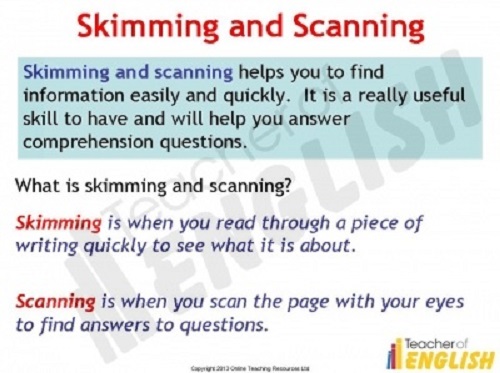Difference between Skimming and Scanning
Skimming and scanning are both reading techniques. These reading skills help students, needing to get information from the written word, access the required information more effectively. They use fast reading abilities but in effect are different methods for different purposes.
What is skimming?
The reader reads an article to get the main ideas and gist of the story. Skimming is used to preview a book quickly to decide if it is worth reading or to cast an eye over an article for the main points. A reader who is skimming can read more text in less time. The text is read with the purpose of finding the main facts. The skill of skimming requires a structure or plan so that not everything is read but the important message is still grasped. The skimmer reads the first few paragraphs in detail to get the general message. Then after that reads the first line of each paragraph, these lines are known as ‘topic sentences.’ The final paragraph is important as it is the conclusion of the article and is read in full as the final message of the article.
The act of skimming has other connotations but the overall message relates to taking something off the top of an item or moving over the top of something.
Skimming:
- An act of taking money or profits off the top of an organisation.
- The act of lifting the cream off the top of the milk or the fat off the top of the liquid. The skimmer only takes the top part of the liquid.
- Describes the act of throwing a flat stone across the water and watching it bounce off the surface and skims to the other side.
- Can be an act of fraud when a credit card is intercepted and duplicated so that funds can be skimmed from the account.
What is scanning?
Scanning is a reading skill that enables the reader to look for a specific piece of information within an item of text. A reader will scan for a particular number in a phone directory for instance or a name on a list. The written articles that are scanned are often written in a particular order or in categories. The scanner has the key words in mind as they scan the list.
The term scanning can be used to refer to other actions associated with looking for something in particular.
Scanning:
- Searching the horizon looking for something in the distance.
- used in the digital world as a machine that scans items to be copied such as documents and certificates.
- Medical technique to look for injury or disease. There are MRI scans, Magnetic Resonance Image and CT or Computed Tomography scans to produce images of body structures.
In the final analysis would these two reading techniques really do justice to reading quality literature? Harold Bloom, a renowned speed reader, is reputed to be able to ‘read’ 1000 pages in an hour. He could devour a novel like Jane Eyre in his lunch break. The average reader would probably have literary indigestion after such a feast of skimming or scanning a classical novel!
- Difference Between Lagoon and Bay - October 20, 2021
- Difference Between Futurism and Preterism - August 12, 2021
- Difference Between Dichotomy and Paradox - August 7, 2021
Search DifferenceBetween.net :
Leave a Response
References :
[0]BealeAbbyMarks.Skimming and Scanning.www.howtolearn.com.4th Feb2013.How to learn.27/10/2017
[1]Skimming and scanning.wwwBBC.co.uk.skillwise/factsheet/BBC.27/10/2017
[2]"Image Credit: http://thefrontseat.weebly.com/study-skills.html"
[3]"Image Credit: http://thefrontseat.weebly.com/study-skills.html"

